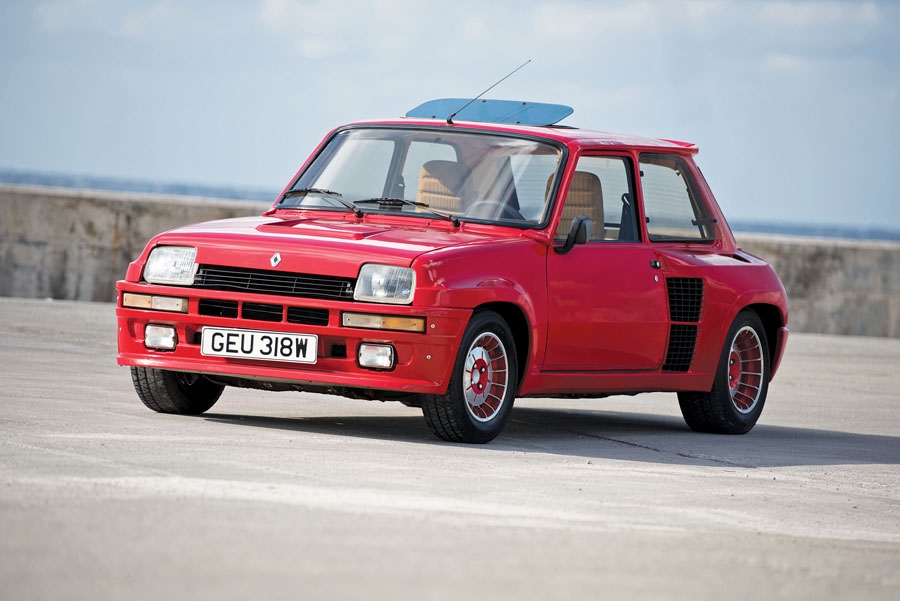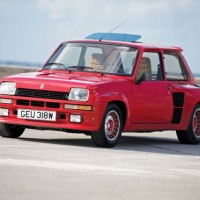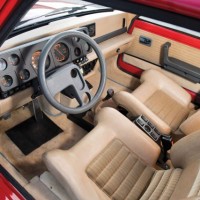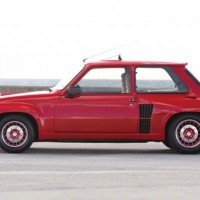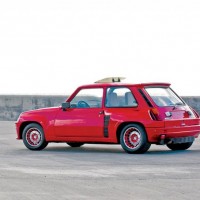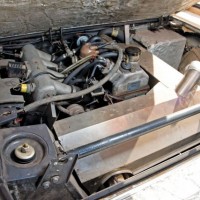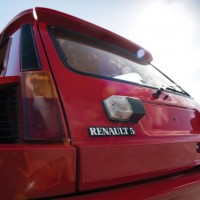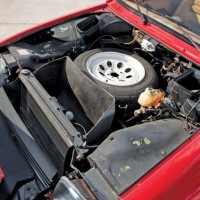The Renault 5 Turbo is a hatchback with a high-performance engine. This French car debuted at the Brussels Motor Show in January of 1980. At this time, rally cars were climbing in popularity. The design of this car was tailored towards the rally car market, but a street version also was sold. During its four-year production run, fewer than 4,000 of these high-performance cars were manufactured.
The Renault 5 Turbo should not be confused with the Alpine Turbo or GT Turbo. This no-nonsense machine was profoundly modified. The turbocharged engine was mounted behind the driver in what is normally the passenger’s compartment, which created a mid-engined hot hatch and rally car. It is also a rear-wheel-drive car. The Renault 5 Turbo was made in many guises and received many plaudits along the way.
Powering this car is a powerful inline 4-cylinder, turbocharged engine. The power transfer to the wide-contact-patch rear tires is a manual gearbox. The exterior is highlighted with red paint and alloy wheels with matching accents, along with a pop-up sunroof. This hatchback has a sporty interior with contoured bucket seats with cloth inserts, electric windows, glove compartment and an efficient dash decorated with gauges. The rear window is fitted with a wiper, and the rear windows are hinged to vent fresh air through the cockpit. The Renault 5 also has numerous ducts and air vents that are seen in black. Even the trailing edge of the roofline has a slight rise to it, giving it the appearance of a subtle spoiler — most fitting for this pure performance platform.
SCM Analysis
Detailing
| Vehicle: | |
| Years Produced: | 1980–86 |
| Number Produced: | 3,576 |
| Original List Price: | N/A |
| SCM Valuation: | $35,000–$65,000 |
| Tune Up Cost: | $200 |
| Distributor Caps: | $18 |
| Club Info: | Renault Turbo Owner’s Club, Renault 5 Turbo Facebook Group |
| Website: | http://www.rtoc.org |
| Alternatives: | 1984–86 Ford RS200, 1980–84 Audi Quattro, 1998 Subaru Impreza 22B |
| Investment Grade: | B |
This car, Lot 472, sold for $50,400, including buyer’s premium, at Auctions America’s Fort Lauderdale, FL, sale on March 28, 2015.
You’d have to look for a long time to find a car that’s been mocked as thoroughly as the Renault 5 — known in the United States as “Le Car.” With just 55 horsepower and looks that only a Renault designer could love, Le Car was forced to compete with the highly successful Honda Civic and Volkswagen Rabbit from 1976 to 1983. But sports car cognoscenti know that there’s a whole universe of difference between Le Car and a Renault 5 Turbo, also known as an R5 Turbo.
Where the Renault Le Car was a front-engine, front-wheel-drive economy car, the R5 Turbo moved the engine behind the driver, gave it a big Garrett turbo, and mated it to a 5-speed transaxle. The mid-engine, rear-drive design put out 160 horsepower and 163 pound-feet of torque and pushed the R5 Turbo from zero to 60 in 6.6 seconds — and to a top speed of about 125 mph.
On the outside, the R5 Turbo sports enormous box flares covering a set of extra-wide rear tires on sexy alloy wheels. Buyers also got a racing-oriented interior package with extra gauges and nifty sport seats. One of the big differences that you can’t see is that the first years of R5 Turbo production were also gifted with aluminum door skins, roof panel and tailgate.
After the original R5 Turbo satisfied the homologation requirements for FIA racing and rally, Renault announced the Renault 5 Turbo 2 in 1982. The Turbo 2 exchanged the expensive aluminum body panels for steel, and downgraded the racing interior to the same economy-car trim delivered with the base model. Over the entire production run from 1980 to 1986, just 3,576 R5 Turbo cars were made — the vast majority being the all-steel Turbo 2 model.
A solid investment
The Renault 5 Turbo is just one of several European cars becoming more collectible in the modern era. Along with other factory racing homologation models such as the Audi Sport Quattro (SCM# 261959), BMW 3.0 CSL (SCM# 239009), and the Ford Escort RS2000 (SCM# 243819), prices have slowly risen for some time. Many collectors have not yet done the homework on these cars, especially when compared with more conventional classic, muscle and sports cars, and that’s helped keep prices reasonable.
That’s all changing now.
If you go back five to 10 years, solid examples of the Renault 5 Turbo were trading at about $30,000–$40,000 (SCM# 120861). However, during the past year, the typical sale price for a good street-going Renault 5 Turbo has generally been north of $100,000. In early February, just six weeks prior to this sale, a 1980 R5 Turbo sold for $117,517 at Rétromobile 2015 by Artcurial in Paris. Just one day before that, a less-desirable 1986 Turbo 2 sold for $91,851 at Bonhams’ Paris auction (SCM# 257280).
This analysis omits the cars with bona fide racing history — they often sell for far more. See the 1980 Renault 5 Turbo Group 4 Race Profile in the May 2014 issue of SCM (p. 62).
An outlier sale
For some reason, this particular car brought less than half the money commanded at other auctions this year. You won’t get much of a clue from the rather perfunctory lot description. You can (and should) learn a lot more about the R5 Turbo.
One strange feature of this car jumps out right away: the sunroof. The R5 Turbo was a homologated racing model, and the factory would never have cut a big hole in the roof. From the photos, this looks to be one of the cheap glass pop-ups that were installed by the millions at car stereo shops — and have been leaking ever since. Strike one, but not a strikeout. A good body shop could easily set that right, even though that roof is aluminum.
The other curious fact to note from the auction description is that this R5 Turbo came with electric windows. The early homologation models were generally fitted with wind-up windows to save weight. Now, this doesn’t mean the car is a fake by any means, but it is unusual for an early-series R5 Turbo.
The rest of the interior is the correct racing-inspired trim for the early model, and apart from a few really minor dings, this car looks like it came from a museum collection — which it did. This car was part of the Cayman Motor Museum Collection before the auction. Bottom line: This is easily a $100,000 car — if not higher.
A cautionary tale
So what’s the answer to this riddle? Note that this car was offered for sale with no reserve. Our best guess is that the collection of buyers at that particular time and in that particular place did not include enough Renault 5 Turbo enthusiasts to boost the price to current market levels. That’s likely because the bidders at this auction had not done the homework on this car’s value. The result is that some lucky buyer just walked away with at least $50,000 of the seller’s equity in his pocket.
This sale should be a cautionary bedtime story for hopeful sellers: You cannot rely on past auction sales to predict the price at the next auction. You need to know what your car is really worth and insist on a reasonable reserve price to ensure that you don’t lose le chemise. ♦
(Introductory description courtesy of Auctions America.)
